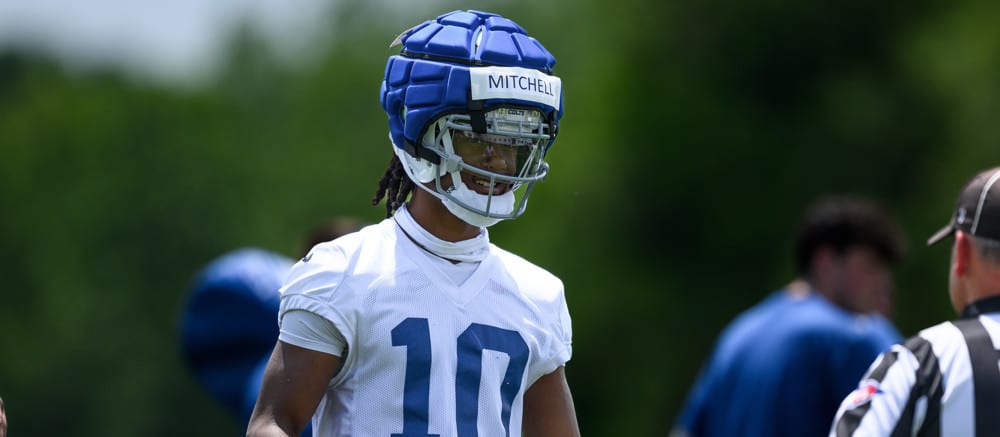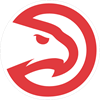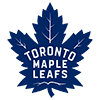Almost everything is permitted as far as what picks might arguably be justifiable for a best ball portfolio, especially big-field tournaments, but there needs to be some point where we draw a line and call something out for its failure to add up. This post attempts to advise against four current picks at ADP, specifically because there is another player later in the ADP at the same position from the same team who will likely score as many or more fantasy points.
Adonai Mitchell, WR, IND (116.1 Underdog ADP)
Mitchell was likely a fine selection for the Colts in the second round, and time may well eventually prove that Mitchell should have gone higher. It's still improbable that he would pay off at this ADP in 2024 given the Colts' schematic tendencies and prior pass-catching personnel.
The Colts will be a run-heavy team in 2024, and they'll run it well. Mitchell might even post high figures in yards per target or/and touchdown rate, making him a meaningful component of an explosive offense, but the volume possibility is almost entirely precluded.
Run-heavy as the Colts might be, Michael Pittman won't be denied as a target – Pittman claimed 30.5 percent of Indy's targets last year and still provided above-baseline returns, outplaying the team catch rate by 4.3 points and the team YPT by 0.2 yards. With only about 70 percent of the pie left you still have to account for Josh Downs, who provided above-baseline returns on an 18.0-percent target
Almost everything is permitted as far as what picks might arguably be justifiable for a best ball portfolio, especially big-field tournaments, but there needs to be some point where we draw a line and call something out for its failure to add up. This post attempts to advise against four current picks at ADP, specifically because there is another player later in the ADP at the same position from the same team who will likely score as many or more fantasy points.
Adonai Mitchell, WR, IND (116.1 Underdog ADP)
Mitchell was likely a fine selection for the Colts in the second round, and time may well eventually prove that Mitchell should have gone higher. It's still improbable that he would pay off at this ADP in 2024 given the Colts' schematic tendencies and prior pass-catching personnel.
The Colts will be a run-heavy team in 2024, and they'll run it well. Mitchell might even post high figures in yards per target or/and touchdown rate, making him a meaningful component of an explosive offense, but the volume possibility is almost entirely precluded.
Run-heavy as the Colts might be, Michael Pittman won't be denied as a target – Pittman claimed 30.5 percent of Indy's targets last year and still provided above-baseline returns, outplaying the team catch rate by 4.3 points and the team YPT by 0.2 yards. With only about 70 percent of the pie left you still have to account for Josh Downs, who provided above-baseline returns on an 18.0-percent target share as a rookie, outplaying the team catch rate by 4.4 points and the YPT by 0.8 yards. Given that Downs turned 22 just before the start of the season and given his above-baseline returns, there's reason to think Downs could claim something to 20.0 percent of the targets while still maintaining plus efficiency.
If half of the pie is gone now – and if the pie portion is less than generous to start with – we might be looking at something like 1,600-to-1,800 yards to split between Mitchell, Alec Pierce, Jelani Woods and whoever else might snag some passes in the Colts offense this year.
And that brings us to Pierce. The former second-round pick who played 695 snaps in 2022 and 1,037 snaps last year. Why is he being written off, exactly? Pierce was admittedly a below-baseline target for Indianapolis last year, but that was a predictable outcome given Gardner Minshew's complete inability to throw the ball downfield. Pierce was reduced to a decoy/desperation target to clear out space underneath, and he did his job. Pierce has a career YPT of 7.74 over 143 targets despite playing with absolute bums at quarterback: Minshew, post-collapse Matt Ryan, Sam Ehlinger, 2022 Nick Foles.
People are understandably excited about Mitchell largely because he is fast and can jump high. Mitchell's 4.34-second 40 at 205 pounds is great, but so is Pierce's 4.42 at 211 pounds. If you were looking specifically for a foil to Mitchell's rookie-year application, Pierce would be one of the top candidates. This is not a problem for a Colts – it makes sense for them to split the playing time between Pierce and Mitchell, or even to give the initial preference to Pierce.
Better teammate pick: Josh Downs (131.2 Underdog ADP), Alec Pierce (215.9 Underdog ADP)
Quentin Johnston, WR, LAC (150.3 Underdog ADP)
It's reasonable enough to want some exposure to Johnston given the durability issues and poor depth of the Chargers wideout rotation otherwise, but one thing people need to let go of now is any fantasy of Johnston emerging as an actual above-average starter in the NFL. It was a botched evaluation and we have to move on.
Johnston is a very athletic person in general and he was very productive at TCU, but the plays on which he produced at TCU either don't exist in the NFL or face off against defenders that Johnston did not see at TCU and that he can't beat with any consistency at the NFL level. More specifically, Johnston torched at TCU in a wide-open offense that created space by running wide-split formations that are illegal in the NFL, and Johnston (4.52-second pro day 40) lacks the raw speed to synthesize that space at the NFL level.
With less space comes more contact, more collisions, and less time to process. If Johnston can't create space himself with speed, then he needs to adapt to a game that plays on a smaller, faster field than the one he saw at TCU. More specifically, Johnston needs to offset his space-related losses by producing more in tight confines – quicker-hitting routes at shallower depths, with more defenders present. Johnston as a mover was never well-situated to quick-hitting routes over the middle, and he lacks the hand coordination to snatch and protect the ball effectively with defenders closing in.
Johnston might not be a bum – he still has time to develop his game more – but the idea of him affecting the NFL game the way he did the college game is expired, permanently. At the very least he needs time to figure things out. For now, exposure should probably remain limited and probably should best be understood as insurance against other Chargers wideouts.
You know who doesn't need any time to figure things out? DJ Chark. Chark has his own limitations – contact suits Chark as bad or worse than it does Johnston, and like Johnston, Chark is liable to drop passes even in the areas of the field where he's ostensibly most comfortable. The difference is crucial, though: Chark might be every bit as space-dependent as Johnston, but with 4.34 speed Chark can and does synthesize space on the boundary and downfield.
The Chargers need a speed-oriented presence on the boundary and downfield to provide a credible long-range threat. If Johnston were faster he would qualify for this function, but Johnston is not fast so he doesn't. Chark is limited in other capacities, but in this one particular role Chark is very effective.
Better teammate pick: DJ Chark (210.2 Underdog ADP)
Troy Franklin, WR, DEN (171.2 ADP)
It appears that the best ball markets are undeterred by Franklin unexpectedly falling to the fourth round of the 2024 draft. Perhaps it's a lot of Narrative lifting doing the work – the idea that Franklin reuniting with Oregon quarterback Bo Nix will give some by-default prominence to Franklin – but Franklin will likely be outproduced this year by both Marvin Mims and Josh Reynolds.
Franklin fell to the fourth round for at least three reasons: (1) he's very skinny at 6-foot-2, 176 pounds, (2) he's not quite as fast as you'd like (4.41-second 40) for a wideout so skinny, and (3) be it due to his light frame or some inadequacy in his hand coordination, Franklin sometimes struggled with drops in the face of contact. Then Franklin reinforced the hands concern by running a memorably brutal Gauntlet drill at the combine, which is normally a pretty good test to gauge a wideout's spatial processing and hand coordination.
Franklin isn't toast as a prospect – he's still pretty fast and his production at Oregon gives reason to believe in long-term developmental potential – but placing Franklin ahead of Mims or Reynolds just wouldn't be based on anything.
First, Reynolds will likely be playing 30 or more snaps almost every week after the Broncos signed him to a two-year, $9 million deal in free agency. Reynolds is the definition of 'average' in almost any capacity, but that makes him a stabilizing presence who's easily deployed through a variety of game plans and situations. He might not be drawing many useful targets, and he won't break open any games on his own, but Reynolds is a reliable pro who will poach a lot of snaps.
Second, it makes no sense in particular for Franklin to go ahead of Mims when Mims is largely just a better version of whatever is supposed to make Franklin theoretically good in the first place. Mims is a rather light receiver himself, but consider how skinny Franklin must be if Mims is seven pounds heavier at nearly three inches shorter. Not just that, but Mims' 4.38-second 40 verifies equal or superior speed to Franklin, even though Mims' frame is a magnitude more dense. Every weakness of Franklin's is an area where he's preempted by Mims.
Mims' rookie year might have been disappointing to his fantasy investors, but the idea that he failed in any way is complete nonsense. Mims did a good job as a 21-year-old speed wideout in an extremely run-heavy, frequently two-tight end offense that already featured Courtland Sutton and Jerry Jeudy.
If Sutton were to be traded before Week 1 then that would admittedly open up more room for Franklin, but he'd still benefit at a slower pace than Mims and Reynolds.
Better teammate pick: Marvin Mims (180.8 Underdog ADP), Josh Reynolds (215.4 Underdog ADP)
Braelon Allen, RB, NYJ (188.1 ADP)
I want to preface this blurb by saying it's the least likely of the four to truly feature a 'Better Teammate' pick in the ADP. As much as some Jets runner could pop up as the clear backup to Breece Hall this year, the best bet might be some incoherent, flippant rotation between Allen, Isaiah Davis and Israel Abanikanda.
With that said, all hype cases for Allen are likely false. Even if the Jets like him, and even if they really want Allen to emerge as the clear backup to Hall, there's still a pressing reason why Allen fell to the late fourth-round in the first place: he likely does not have NFL speed. If an otherwise productive running back with standout power and third-down potential (all true!) falls to the fourth-round compensatory picks then something must be amiss.
What's missing is obvious: Allen likely runs a 4.80 40-yard dash at best, and no running backs in recent memory have played extensively in the NFL with testing that poor. Watch Allen's games against Purdue in 2021 and 2023 – in the first game Allen had a sprint run where he gets ran down by a safety who ran a 4.64-second pro day 40, and a corner who ran a 4.80 pro day 40 keep stride with Allen. In the 2023 game against Purdue there once again was an open sprint play for Allen, and this time he got ran down from behind by defensive end Kydran Jenkins. Jenkins looks like a hell of a player and will probably test well at his combine, but it's still jarring to see Allen get caught so easily from so far back by a guy over 260 pounds.
If Allen runs in the 4.8-second range then his dimensions and collegiate production are basically identical to John Clay, who went undrafted and played a few garbage time snaps with the Steelers before concluding his career. Allen's production was no better than the likes of Clay, P.J. Hill, Corey Clement or Montee Ball, and his athletic testing is worse than all of them but Clay. The most successful NFL runners with a 4.80 40 or worse is probably actually Le'Ron McClain, who was more so a fullback.
Rather than Allen, the better candidates to prove viable for more than 15 snaps or so in a game are Davis and Abanikanda. Davis is the more powerful of the two and Abanikanda the raw but more dangerous big-play threat, but Davis would probably have the upper hand since he's more polished than Abanikanda on passing downs. When you have three unproven, incomplete players auditioning at the same time, though, the most likely outcome is probably a rotation based on situation or whim.
Better teammate pick: None/Isaiah Davis (216.0 Underdog ADP)








































